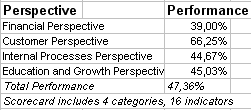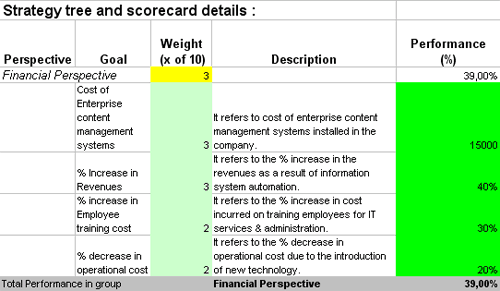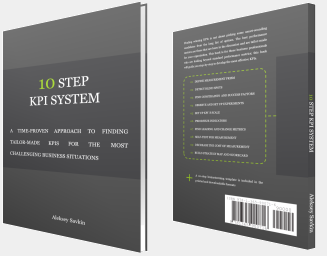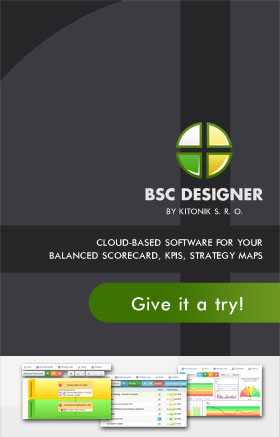 These days, organizations use various strategies to stay competitive in the highly competitive business world. One such strategy is enterprise content management. It is a new concept that is gaining wide acceptance and recognition by many organizations. Technologies that can be used to capture, store, preserve, and deliver the contents related to the organization and its processes are included in enterprise content management. But its successful implementation requires a constant supervision. For this purpose, KPI s can act as a supportive tool.In this regard, KPIs can be categorized into four broad perspectives- Financial perspective, customer perspective, internal process perspective and education and growth perspective.Financial perspective includes KPIs like cost of enterprise content management systems, percentage increase in the revenues, percentage increase in employee training cost and percentage decrease in operational cost. It provides a financial overview of enterprise content management activities.Customer perspective is the second perspective and comprises of indicator like percentage incidents resolved at first contact, number of customer complaints, percentage reduction in file request time and number of content management specialists.KPIs such as new technology installed, percentage paperwork reduction, total spam control and percentage error reduction are included in internal processes perspective, signifying all the measures used to improve services. Last perspective, i.e. education & growth, consists of KPIs like number of training sessions, number of continuous learning sessions held for top management, percentage of employees with their own ID and password and number of inter-group coordinations.
These days, organizations use various strategies to stay competitive in the highly competitive business world. One such strategy is enterprise content management. It is a new concept that is gaining wide acceptance and recognition by many organizations. Technologies that can be used to capture, store, preserve, and deliver the contents related to the organization and its processes are included in enterprise content management. But its successful implementation requires a constant supervision. For this purpose, KPI s can act as a supportive tool.In this regard, KPIs can be categorized into four broad perspectives- Financial perspective, customer perspective, internal process perspective and education and growth perspective.Financial perspective includes KPIs like cost of enterprise content management systems, percentage increase in the revenues, percentage increase in employee training cost and percentage decrease in operational cost. It provides a financial overview of enterprise content management activities.Customer perspective is the second perspective and comprises of indicator like percentage incidents resolved at first contact, number of customer complaints, percentage reduction in file request time and number of content management specialists.KPIs such as new technology installed, percentage paperwork reduction, total spam control and percentage error reduction are included in internal processes perspective, signifying all the measures used to improve services. Last perspective, i.e. education & growth, consists of KPIs like number of training sessions, number of continuous learning sessions held for top management, percentage of employees with their own ID and password and number of inter-group coordinations.
Read Why do business professionals choose ready-to-use KPIs? to find out the answers to these questions:

Ideally, you need to have a strategy (in a form of a strategy map) before you start thinking about the ways to measure its execution (KPIs). Don't have a strategy map yet? Use free Strategy Map Wizard to create a strategy map for your current business challenges. The wizard will:
The whole process takes on average 6 minutes. Give it a try right now - it's free.
Managing content in an organization is a subject that hardly needs to be emphasized, as the
successful running of a firm is dependent on the 'availability of right information at right time'. This in turn, is possible only if the content has been well placed in reservoirs and databases. One not only needs to acquire the authenticated data from genuine sources but also has to be managed (this covers up-dations, additions, deletions etc.).
A yardstick for keeping an eye on the how the things have been going on is a must in this regard.
Various IT enabled solutions are available in the market to assist organizations in this task. DMS (Document Management System) is one such answer. This computer application is used to carry out a major chunk of tasks that come under the 'content management umbrella'.
One can broadly divide CMSes into four categories- Enterprise CMS, Mobile CMS, Component CMS and Web CMS.
Some of the features that a CMS is expected to support are 'identifying the key users of the CMS and knowing about the roles played by them', 'capability to allocate roles and responsibilities to users', 'feature of capturing data', 'separate presentations of content' etc.


This is the actual scorecard with Content Management Indicators and performance indicators. The performance indicators include: content management, financial perspective, cost of enterprise content management systems, % increase in revenues, % increase in employee training cost, % decrease in operational cost, customer perspective, incidents resolved, % reduction in file request time, number of customer complaints, number of content management specialists, internal processes perspective, new technology installed, total spam control, % paperwork reduction, % error reduction, education and growth perspective, training sessions, % of employees with id & password, number of continuous learning sessions held for top management, number of inter-group coordinations .
Download a trial version of Content Management Estimation Balanced Scorecard or purchase a full version online.

How is this book different from 796 other book titles about KPIs on Amazon?
"Before writing a single line, I formulated some guiding principles, one of them was: "If our clients ask, "How can I find a good KPI for..." - I want this book to provide a perfect answer."
